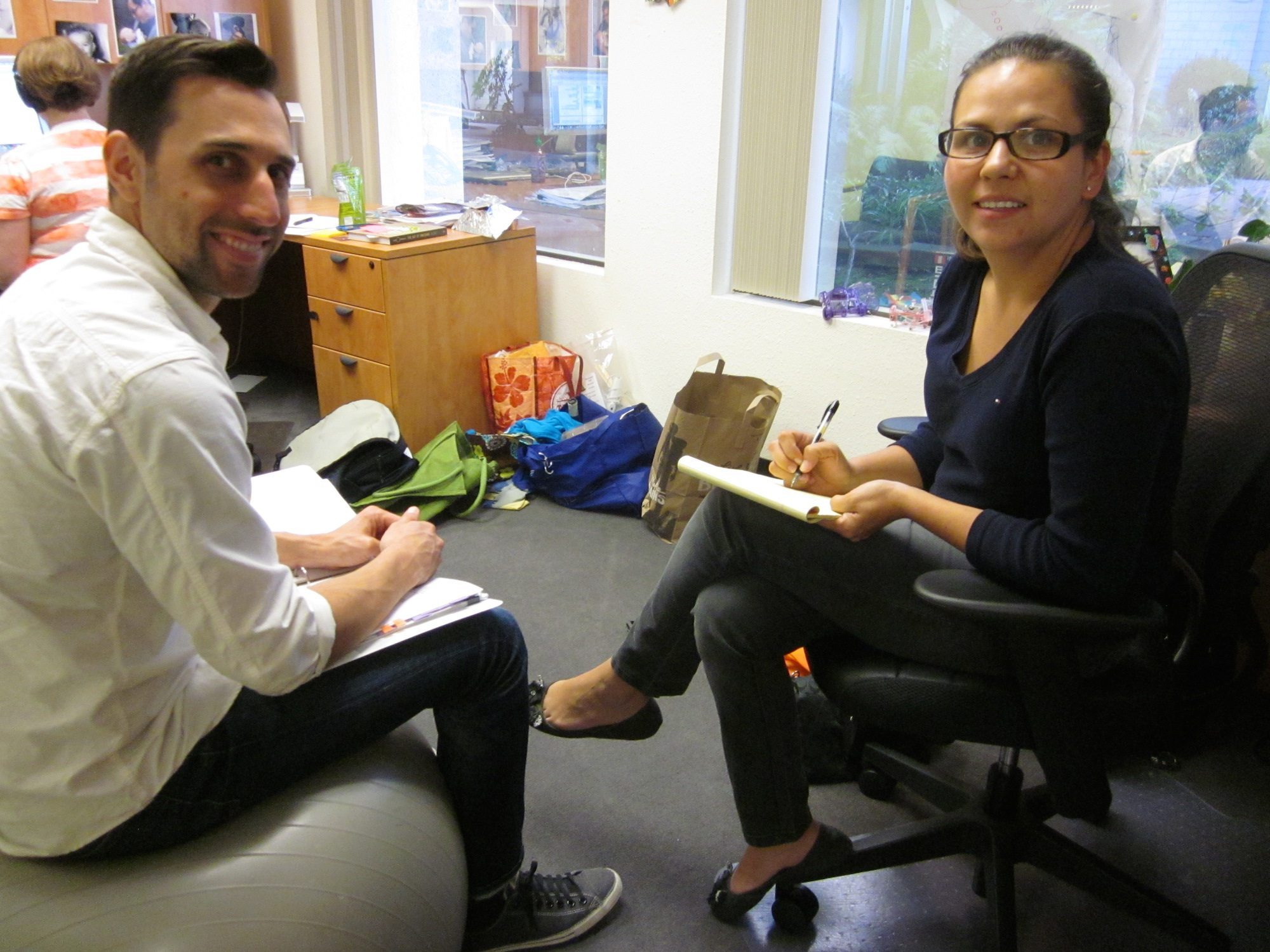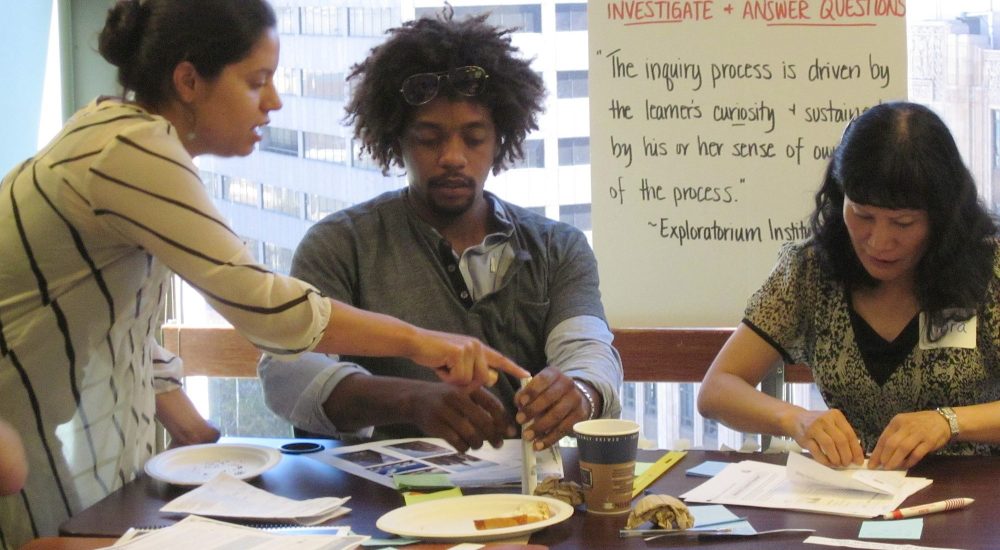I was in a meeting recently and was offered a suggestion:
To invite my staff to play back what they heard during discussions in order to reduce the chance for misunderstandings. I appreciated this feedback because it was practical and addressed an area of growth for me. It was especially meaningful since the feedback was from someone whom I supervise. I know that it’s not always easy to offer up constructive feedback to a supervisor.
Feedback within an organization: Practice makes better
It takes determination and practice to make feedback part of the practice of our organizations. At Techbridge we encourage all staff to offer feedback on what is working well as well as areas in need of improvement. This goal came out of our recent performance review process in which areas for improvement surfaced. There were a smattering of challenges described in peer and supervisor reviews that had not been shared between supervisors and staff during the year. Next year, we don’t want any surprises or missed opportunities for making changes and improving practices with more timeliness.
We recognize that while giving more and better feedback is a goal, it is a work in progress at Techbridge. Jane MacKenzie, Chair of our Board of Directors, offered up her help and hosted training for our staff. Jane is General Manager for Global Workforce Development at Chevron and she shared research and encouraged us to role play and practice some of the strategies she recommended. We know that a one-time training isn’t enough and plan to revisit our staff needs for additional training later in the year.
Feedback to partners: Regard it as a gift
Offering feedback is also important for the partners we work with.
We introduce our girls to role models who dispel stereotypes and inspire our girls in science, technology, and engineering. They come to our after-school programs and host field trips. Knowing how to be an effective role model is not something one learns in college or on the job. In order to support their success, it is important for us to share feedback with role models.
At the start, our staff wanted to focus only on the positive because role models were volunteering their time. While we want to recognize and reinforce what role models get right, it is important to note where role models (and Techbridge) can improve. We’ve learned that while it may be hard at first, it is important to engage in candid discussions with role models.
Looking at feedback as a gift instead of an indication of a shortcoming is a perspective that helps guide us. It helps to set up the expectation from the start that follow-ups are part of successful partnerships and feedback supports program improvement. Starting these conversations by asking partners for their help on what they think can be improved makes it easier to share feedback on how they can also improve.
Everyone wants to help when they are asked. Quality feedback makes for lasting partnerships. With practice and training it does get easier to provide feedback.

Techbridge’s Top 10 Tips for Making Feedback Part of our DNA:
- For most of us, feedback can sometimes be hard to give and receive. Provide training so that everyone in your organization gets more comfortable and more skilled. It takes practice and with time will become easier and more effective. It helps to remember that we are all works-in-progress.
- Make it timely. When you see or hear something that you want to reinforce, let your staff know what they have successfully accomplished. Be specific on what made their behavior effective. Did they walk around the classroom and make sure that all kids were engaged with hands-on materials? Did they demonstrate growth in giving directions and managing behavior since your last visit?
- In instances when you can’t provide immediate feedback, find the next appropriate moment to share your comments. Or, send a quick email or write a note that captures your insights and can serve as the basis for a discussion the next time you meet.
- Techbridge after-school programs end with shout outs. We learned this from one of our program coordinators. Our girls share out and acknowledge and appreciate the actions of others. They note the partner who helped them work through a design challenge, the teacher who encouraged them to persevere, or the role model who visited their school. We brought this practice back to our office and end team meetings with shout outs. Help with a weekend family event, review of new curriculum, and success in managing a challenging partnership are examples of shout outs that appreciate the collective efforts of our team.
- Find out the preference for how each staff wants to receive feedback. Each of us is different. A private note may be more appropriate for some. A public remark during a meeting may work better for others.
- For managers, make it a standard practice to ask a question during check-ins to make sure that they are providing feedback to their direct reports. Ask them for an example of when they provided feedback on successful work and when they provided input on a skill that needed improvement.
- Positively reinforce feedback. When someone offers up feedback, thank them for caring enough to offer a suggestion on how to improve. This is particularly important for supervisors since it can be intimidating to offer constructive feedback to someone with more authority.
- Managers, give your team a box of thank-you notes to support their giving of feedback. Let them know that you will be checking back to make sure they use them up in a timely way.
- We invite partners to visit our programs and see us in action. We ask that they follow up with feedback. We learned this effective practice from Galileo Learning. In advance of a visit to one of their trainings, Glen Tripp, CEO and Founder, requested that we share at least one piece of constructive feedback with him. We liked the idea so much that we stole it!
- Random acts of feedback are demonstrations of caring. They help us thrive in our work. The benefits go round and round. The person who receives feedback feels better and becomes more effective at the job. The person who provides the feedback feels good and knows that she or he is cultivating leadership within.
For breakfast today, I had coffee and granola. I shared breakfast over a phone call with Elizabeth Hodges, who is Executive Director in our Greater Seattle office. We may be in different cities, but we share a common commitment to inspiring the next generation of innovators and leaders. In these calls, we can offer input to one another and work on our feedback muscle.
 Author: Linda Kekelis
Author: Linda Kekelis
Executive Director
Techbridge
Oakland, CA
Linda Kekelis is Executive Director of Techbridge, a program that inspires girls in science, technology, and engineering. With over 20 years’ experience designing and leading girls’ programs, Linda participates in advisory boards, collaborates with girl-serving organizations, and works with professional groups and corporate partners to promote females’ participation in science, technology, and engineering. She conducts research, participates in national conferences, and writes, translating research into practical applications for educators, professionals, and parents. She has a doctorate in special education from the University of California, Berkeley.
